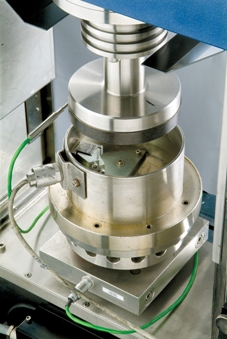Bench for Frictional and Wear Tests
Advantages
- Highly reproducible due to constant testing conditions
- Manifold sample geometries near to application cases
- such as pins of 4 to 20 mm diameter, rings (max. diameter 112 mm) Component testing feasible
- Qualitative assessment of materials under conditions near to practice
Parameters
- Testing load 0 ... 5,000 N
- Friction couple to be dissolved in cycles
- Rotation to the right/left up to 8,000/min
- Heating of the testing installation to about 300 °C
- Testing under inert gas, fluid or abrasive media
- Rotating motion can be overlaid by vibration
- Oscillation from 35° to 350°
- Stop braking upon electronic rotating mass simulation
Measuring variables
- Frictional moment (max. 10 Nm)
- in situ measurement of total abrasion
- Temperature
- Acoustic emission
Range of applications
- Materials development
- Generation of material data sheets
- Pin/disk testing according to DIN 50324
- Testing of friction couples at original parts vibrating in rotating direction whereby vibration is overlaid a very low speed value (amplitude and frequency can be selected), at increased testing temperature.
- Operational testing (stop braking) of materials for clutches and brakes
- Testing of friction couples whereby rotating direction is changed (moving about, hinges or plunger/ cylinder) by oscillating rotating motion
- Testing on impacts by abrasive media, Testing installation pin/ disk, or ring/ disk with cyclic dissolving and pressing against the frictional couple, thus, fresh abrasive material is getting to the frictional surface again and again.
 Fraunhofer Institute for Manufacturing Technology and Advanced Materials IFAM
Fraunhofer Institute for Manufacturing Technology and Advanced Materials IFAM
